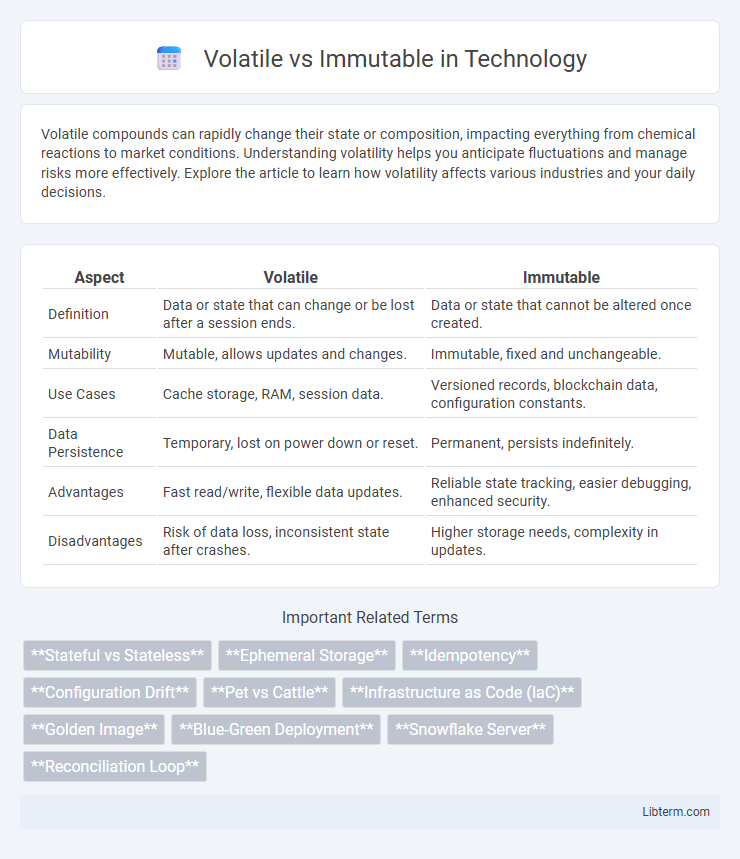Volatile compounds can rapidly change their state or composition, impacting everything from chemical reactions to market conditions. Understanding volatility helps you anticipate fluctuations and manage risks more effectively. Explore the article to learn how volatility affects various industries and your daily decisions.
Table of Comparison
| Aspect | Volatile | Immutable |
|---|---|---|
| Definition | Data or state that can change or be lost after a session ends. | Data or state that cannot be altered once created. |
| Mutability | Mutable, allows updates and changes. | Immutable, fixed and unchangeable. |
| Use Cases | Cache storage, RAM, session data. | Versioned records, blockchain data, configuration constants. |
| Data Persistence | Temporary, lost on power down or reset. | Permanent, persists indefinitely. |
| Advantages | Fast read/write, flexible data updates. | Reliable state tracking, easier debugging, enhanced security. |
| Disadvantages | Risk of data loss, inconsistent state after crashes. | Higher storage needs, complexity in updates. |
Understanding Volatile and Immutable: Definitions
Volatile refers to data that can change rapidly during program execution, making it essential for variables in multi-threaded environments to maintain up-to-date values. Immutable describes data or objects that cannot be altered after creation, ensuring consistency and thread safety without synchronization overhead. Understanding these concepts helps optimize memory management and concurrency control in software development.
Key Differences Between Volatile and Immutable
Volatile variables allow changes in state, making them suitable for scenarios requiring up-to-date data but can lead to inconsistent reads in concurrent environments. Immutable objects, once created, cannot be altered, ensuring thread safety and predictability by avoiding side effects. Key differences lie in mutability, thread safety, and use cases, with volatile supporting dynamic updates and immutable guaranteeing stability and consistency.
How Volatile Variables Work in Programming
Volatile variables in programming are used to indicate that a variable's value can be changed by different threads or processes without synchronization, ensuring the compiler does not optimize code in a way that assumes the value is constant. When a variable is declared volatile, every read or write operation goes directly to the main memory, preventing stale or cached copies from being used. This mechanism is crucial in concurrent programming for maintaining data consistency and visibility across multiple threads.
The Role of Immutable Objects in Software Design
Immutable objects play a critical role in software design by ensuring thread safety and reducing side effects, which enhances code reliability and maintainability. Unlike volatile variables that guarantee visibility but not atomicity, immutable objects cannot be altered after creation, simplifying concurrent programming and avoiding synchronization issues. This design choice improves predictability and facilitates easier debugging, testing, and reasoning about program behavior.
Performance Implications: Volatile vs Immutable
Volatile variables guarantee visibility of changes across threads but can incur performance costs due to frequent memory synchronization and cache invalidation. Immutable objects eliminate the need for synchronization, enhancing read performance and reducing contention in concurrent environments. Choosing immutability often leads to better scalability and predictability in multi-threaded applications compared to volatile variables.
Use Cases: When to Choose Volatile or Immutable
Volatile variables are ideal for scenarios requiring frequent updates and visibility across multiple threads, such as status flags or configuration settings in concurrent programming. Immutable objects are preferred for data safety and consistency, especially in multi-threaded environments, caching mechanisms, and functional programming where data should not change after creation. Choosing volatile suits dynamic state management, while immutable ensures thread-safe, predictable behavior without synchronization overhead.
Thread Safety Considerations
Volatile variables ensure visibility of changes across threads by preventing caching in CPU registers, which helps maintain read consistency but does not guarantee atomicity for compound operations, making them suitable for simple flags or state indicators. Immutable objects, by their nature, are inherently thread-safe since their state cannot change after construction, eliminating synchronization concerns and data races during concurrent access. Choosing between volatile and immutable depends on the need for write operations and state mutation complexity, with immutability preferred for complex shared data to achieve robust thread safety.
Common Pitfalls and Best Practices
Volatile variables in concurrent programming can lead to visibility issues and race conditions if not used properly, as changes to volatile fields are immediately visible to other threads but lack atomicity for compound actions. Immutable objects eliminate synchronization concerns by ensuring state cannot change after creation, promoting thread safety and simplifying concurrent designs. Best practices include using volatile only for flags or state indicators that require visibility without atomicity and preferring immutable objects to avoid common pitfalls like inconsistent state and hard-to-debug concurrency bugs.
Examples in Popular Programming Languages
In Java, the `volatile` keyword ensures visibility of changes to variables across threads, as seen in example code where a volatile boolean flag controls thread execution, while immutable objects like `String` guarantee thread safety by preventing state changes after creation. In Python, immutable types such as tuples or strings cannot be altered once created, providing predictability and safe sharing across functions, whereas volatile behavior is mimicked using synchronization mechanisms like threading locks. C++ offers `std::atomic` variables to handle volatile-like operations safely in concurrent contexts, whereas immutable patterns are implemented via `const` correctness or by using classes designed without setters, exemplified by `std::string` immutability in certain designs.
Conclusion: Making the Right Choice
Choosing between volatile and immutable data structures depends on the specific requirements of performance, safety, and concurrency in your application. Volatile structures offer flexibility and speed for scenarios with frequent state changes, while immutable ones provide thread safety and predictable state management essential for concurrent environments. Evaluating the trade-offs in mutability, memory overhead, and complexity ensures the right choice aligns with the application's goals.
Volatile Infographic

 libterm.com
libterm.com